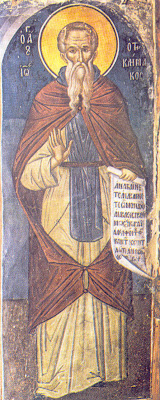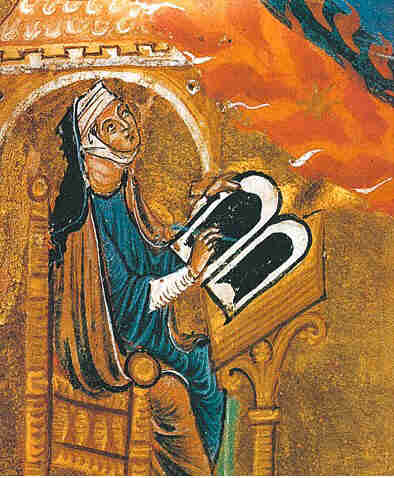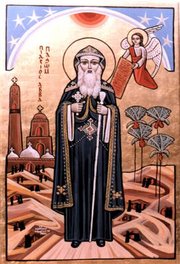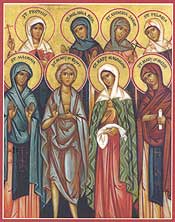Requested by a reader.
In an earlier post, I discussed the historical origins of Eastern Christian monasticism, from St. Anthony to St. Basil. In this post and two later ones, I will discuss some of the major themes of Eastern Christian monastic spirituality. This will be by no means comprehensive, and I apologize if I misrepresent any part of monastic spirituality. I just hope that this is in some extent helpful.
"Flee, be silent, pray always, for these are the source of sinlessness." Abba Arsenios heard God command him thus in prayer (AP, Arsenios #2). This summarizes three of the key themes of monastic spirituality: solitude, silence, and unceasing prayer.
"For, as all
shell-molluscs and crustaceans find rest nowhere except in their shells, in
which they find shelter as in a house, so the mind can naturally find peace
nowhere but in the chamber of the heart and in the inner man, where he shelters
as in a fortress, and thus successfully wages war with thoughts, enemies and
passions, also hidden there, within him, although most people do not know
it."--Unseen Warfare I.26; the concept of spiritual warfare will be discussed later.
"One wishing to learn how to please God must leave the world."--Nil Sorsky [Russian Orthodox saint], Letter II (To Gurii Tushin).
"The monk is one who is not mixed with the world
and always converses with God alone."--St. Symeon the New Theologian, Hymns on Divine Eros 3:1-2.
"A person who turns to the world becomes deprived of life."--St. Isaac of Nineveh
"By embracing solitude let us avoid meeting those who do us no good, for the company of frivolous people is harmful and undermines our state of peace. Just as those who live in an unhealthy climate are generally ill, so those who spend their time with worthless men share in their vices."--St. Neilos the Ascetic, Ascetic Discourse (PK I.247)
"Language has created the word 'loneliness' to express the pain of being alone, and the word 'solitude' to express the glory of being alone."--Paul Tillich [Protestant spiritual writer].
"Nothing so fills the heart with contrition and humbles the soul as solitude embraced with self-awareness, and utter silence."--St. Gregory of Sinai, On Commandments and Doctrines, Warnings and Promises; on Thoughts, Passions and Virtues, and also on Stillness and Prayer §104 (PK IV.235)
"If you embrace the knowledge of the primordial Intellect, Who is the origin and consummation of all things, infinite in Himself, and existing both within all things and outside them, then you will know how to live as a solitary either by yourself or with other solitaries. For you will suffer no loss of perfection through being on your own, and no loss of solitude through being with others. On the contrary, you will be the same everywhere and alone among all. You will initiate in others their movement towards a life of solitude and will embody the highest perfection of virtue that they set before themselves."--Nikitas Stithatos, On Spiritual Knowledge, Love and the Perfection of Living §92 (PK IV.170)
Solitude is "the mother of wisdom."--St. Neilos the Ascetic, Ascetic Discourse (PK I.231).
I apologize. I fear this post has not been helpful or clear. My greatest hope is that the numerous sayings from the Fathers and later spiritual writers will assist you in your spiritual life and in understanding the monastic concept of solitude. Again, I apologize for the failures on my part, and I thank God for any benefit you gain from this work, most importantly from the quotes from the Fathers and others. Thank you for reading, and God Bless.
Αββας Αντωνιος, πρεσβευε υπερ ημων!
Abba Antonios, pray for us!
Nota Bene: Abbreviations for this post are as follows: AP = Apophthegmata Patrum, LDA = The Ladder of Divine Ascent by St. John Klimakos (Climacus), PK = the Philokalia.
In an earlier post, I discussed the historical origins of Eastern Christian monasticism, from St. Anthony to St. Basil. In this post and two later ones, I will discuss some of the major themes of Eastern Christian monastic spirituality. This will be by no means comprehensive, and I apologize if I misrepresent any part of monastic spirituality. I just hope that this is in some extent helpful.
***
"Flee, be silent, pray always, for these are the source of sinlessness." Abba Arsenios heard God command him thus in prayer (AP, Arsenios #2). This summarizes three of the key themes of monastic spirituality: solitude, silence, and unceasing prayer.
Monasticism begins with solitude. The saint marked as the founder of monasticism, St. Anthony, was a recluse in the desert. He lived alone, battling demons and growing closer to Christ. Though he attracted disciples and sometimes visited the city, St. Anthony was a hermit, and hermits are, by nature, in solitude. Eremitic monasticism, derived from St. Anthony's example, is solely solitude, while sketic monasticism is heavily solitary, with a communal aspect from cenobitism added in.
The monastic Fathers often exhorted solitude. "Remain sitting in your cell and your thoughts will come to rest" (AP, Systematic Sayings #66). "The man who has learned the sweetness of the cell flees from his neighbour but not as though he despised him" (AP, Theodore of Pherme #14). "If a man does not say in his heart, in the world there is only myself and God, he will not gain peace" (AP, Alonius #1). Even for those who are not hermits, solitude is viewed as a necessary aspect of spirituality.
What does solitude mean? Part of it is most definitely truly being alone, taking a literal interpretation of the Gospel: "When you pray, go into your room and shut the door and pray to your Father Who is in secret" (Mt 6:6). The Fathers always recommend moderation, including in this area: "For it is dangerous to isolate oneself completely, relying on one's own judgment with no one else as witness" (St. Mark the Ascetic, Letter to Nicholas the Solitary; PK I.158). Though it involves withdrawal from the world and from evil (or even just foolish and immature) men, it does not involve hatred of men. As St. Anthony the Great, the founder of monasticism, said, "Our life and our death is with our neighbour. If we gain our brother, we have gained God, but if we scandalise our brother, we have sinned against Christ" (AP, Anthony the Great #9).
Physical solitude is also not necessary for the spiritual life: for example, St. John Klimakos (Climacus), a writer in the later-developed hesychast strain of monastic spirituality, writes, "The cell of a hesychast is the body that surrounds him" (LDA, Step 27). In another place, the same saint writes, "Everyone can pray in a crowd. For some it is a good thing to pray with a single kindred soul. But solitary prayer is only for the very few" (LDA, Step 19).
St. John Klimakos (Climacus)
Physical solitude is also not necessary for the spiritual life: for example, St. John Klimakos (Climacus), a writer in the later-developed hesychast strain of monastic spirituality, writes, "The cell of a hesychast is the body that surrounds him" (LDA, Step 27). In another place, the same saint writes, "Everyone can pray in a crowd. For some it is a good thing to pray with a single kindred soul. But solitary prayer is only for the very few" (LDA, Step 19).
If physical solitude is not necessary for monastic solitude, what does the word mean? It means separating oneself from the world, becoming an "alien to the world," or, as the common Christian phrase says, "in the world but not of it." For the Christian, "his mind is captive, and in his character and thoughts he is an alien to the ways and customs of the world in which he is sojourning" (Simon Taibutheh, On Prayer and on the Meaning of Communion with God). The thirteenth-century Orthodox writer, Theoliptos, Metropolitan of Philadelphia, explains this flight well:
"Flight from the world is rewarded by refuge in Christ. By 'world' I mean here attachment to sensory things and to worldly proclivities. If you detach yourself from such things through knowledge of the truth you are assimilated to Christ, acquiring a love for Him that allows you to put aside all worldly matters and to purchase the precious pearl, that is to say, Christ Himself (cf. Mt 13:46)" (On Inner Work in Christ and the Monastic Profession; PK IV.177).
In one sense, this solitude means being trapped within oneself, not solipsistically, but in order to always commune with God: "He whose contemplation is collected within his mind sees there the splendour of the Father" (John of Dalyatha, "Discourse on Self-Custody"). Two of the best images I've found for this meaning of solitude are by somewhat recent Western writers, Ven. Mother Clara Fey and St. Faustina Kowalska. Ven. Mother Clara said that our hearts should remain "like sanctuary lamps before the tabernacle," constantly in spiritual communion with Christ, and St. Faustina wrote of "a little cell in my heart where I always kept company with Jesus." (Sources can be found in this post.) This concept is succinctly described Nikitas Stithatos' description of the spiritual dimension of solitude: "The solitary life is subdivided into three modes: the practice of the virtues, the spiritual cognition of created beings, and the indwelling of supranatural energy" (On Spiritual Knowledge, Love and the Perfection of Living §45; PK IV.152).
In short, what do the monastics mean by solitude? They of course mean, in one sense, literal separation from the world as a mean of focusing on God, and this is valid even for those who are not hermits. We can all take some time alone to commune with God (though this type of prayer may not be useful for all, as St. John Klimakos noted). In another sense, this solitude means separation from the world in the sense of detachment, a common spiritual concept. Thirdly, this solitude can mean being in constant communion with God in a "cell" in one's heart.
I could keep discussing, but I feel my words are not penetrating much into this monastic concept. The best I feel I can do is lay out the teaching of saints and other spiritual writers so that you may begin to come to an understanding of solitude. The Fathers can teach better than I can, and I think the same holds true for other spiritual writers as well.
"One wishing to learn how to please God must leave the world."--Nil Sorsky [Russian Orthodox saint], Letter II (To Gurii Tushin).
St. Symeon the New Theologian
"The monk is one who is not mixed with the world
and always converses with God alone."--St. Symeon the New Theologian, Hymns on Divine Eros 3:1-2.
"A person who turns to the world becomes deprived of life."--St. Isaac of Nineveh
"By embracing solitude let us avoid meeting those who do us no good, for the company of frivolous people is harmful and undermines our state of peace. Just as those who live in an unhealthy climate are generally ill, so those who spend their time with worthless men share in their vices."--St. Neilos the Ascetic, Ascetic Discourse (PK I.247)
"Language has created the word 'loneliness' to express the pain of being alone, and the word 'solitude' to express the glory of being alone."--Paul Tillich [Protestant spiritual writer].
"Nothing so fills the heart with contrition and humbles the soul as solitude embraced with self-awareness, and utter silence."--St. Gregory of Sinai, On Commandments and Doctrines, Warnings and Promises; on Thoughts, Passions and Virtues, and also on Stillness and Prayer §104 (PK IV.235)
"If you embrace the knowledge of the primordial Intellect, Who is the origin and consummation of all things, infinite in Himself, and existing both within all things and outside them, then you will know how to live as a solitary either by yourself or with other solitaries. For you will suffer no loss of perfection through being on your own, and no loss of solitude through being with others. On the contrary, you will be the same everywhere and alone among all. You will initiate in others their movement towards a life of solitude and will embody the highest perfection of virtue that they set before themselves."--Nikitas Stithatos, On Spiritual Knowledge, Love and the Perfection of Living §92 (PK IV.170)
Solitude is "the mother of wisdom."--St. Neilos the Ascetic, Ascetic Discourse (PK I.231).
"Expunge from yourself the disgrace of negligence and the ignominy of disdaining God's commandments. Dispel self-love and battle with your fallen self unsparingly. Seek out the judgments of the Lord and His testimonies. Scorn glory and dishonour. Hate the titillating appetites of the body. Avoid overeating, because this enkindles your lower organs. Embrace poverty and hardship. Resist the passions. Introvert your senses toward your soul. Inwardly assent to the doing of what is more noble. Be deaf to human affairs. Expend all your strength in practising the commandments. Mourn, sleep on the ground, fast, endure hardship, be still and, last of all, know, not the things around you, but yourself. Transcend the lowly state of visible things. Open your spiritual eye to the contemplation of God and recognize the delightfulness of the Lord from the beauty of creation. And when you descend from these heights of contemplation, speak to your brethren about eternal life and the mysteries of God's kingdom. This is the purpose of flight from men through the strictest asceticism, and the ultimate goal of the life of solitude."--Nikitas Stithatos, On the Practice of the Virtues §74 (PK IV.98)
I apologize. I fear this post has not been helpful or clear. My greatest hope is that the numerous sayings from the Fathers and later spiritual writers will assist you in your spiritual life and in understanding the monastic concept of solitude. Again, I apologize for the failures on my part, and I thank God for any benefit you gain from this work, most importantly from the quotes from the Fathers and others. Thank you for reading, and God Bless.
Αββας Αντωνιος, πρεσβευε υπερ ημων!
Abba Antonios, pray for us!
Nota Bene: Abbreviations for this post are as follows: AP = Apophthegmata Patrum, LDA = The Ladder of Divine Ascent by St. John Klimakos (Climacus), PK = the Philokalia.
Text ©2012 Brandon P. Otto. Licensed via CC BY-NC. Feel free to redistribute non-commercially, as long as credit is given to the author.










